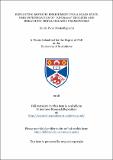Files in this item
Exploiting isotopic enrichment for a solid-state NMR investigation of “ADORable” zeolites and breathing metal-organic frameworks
Item metadata
| dc.contributor.advisor | Ashbrook, Sharon E. | |
| dc.contributor.advisor | Morris, Russell Edward | |
| dc.contributor.author | Bignami, Giulia Paola Maria | |
| dc.coverage.spatial | xii, 249 p. | en_US |
| dc.date.accessioned | 2018-06-18T13:23:34Z | |
| dc.date.available | 2018-06-18T13:23:34Z | |
| dc.date.issued | 2018-06-27 | |
| dc.identifier.uri | https://hdl.handle.net/10023/14202 | |
| dc.description.abstract | This thesis combines synthetic studies for isotopic enrichment with solid-state characterisation techniques to investigate two classes of microporous materials: zeolites and metal-organic frameworks (MOFs). These materials have a wide range of successful applications, from industrial catalysis to medicine, resulting in the increasing need for both a complete understanding of their unique structural features and synthetic methods to target new frameworks. Nuclear magnetic resonance (NMR) spectroscopy, thanks to its sensitivity to the local, atomic-scale, environment and its element specificity, is applied, in combination with powder X-ray diffraction (PXRD), electron microscopy, N₂ adsorption and mass spectrometry, to the study of these materials. Oxygen atoms play a crucial role in the structure and chemistry of zeolites and MOFs, making ¹⁷O NMR an excellent tool for chemical and structural investigations. However, the low natural abundance of this isotope (0.037%) and the cost of ¹⁷O-enriched reactants require the development of atom-efficient synthetic processes for isotopic enrichment. In the first part of this work, the unconventional assembly-disassembly-organisation-reassembly (ADOR) method is applied to the Ge-doped UTL framework and optimised in reduced-volume conditions for economic enrichment to obtain ¹⁷O- and ²⁹Si-enriched UTL-derived zeolites. In situ and ex situ solid-state characterisation studies show that isotopic enrichment not only enables a more detailed spectroscopic investigation, but also provides new insights into the mechanism of the ADOR process and its sensitivity to experimental conditions. In the second part of this work, dry gel conversion synthesis and a novel steaming procedure are studied as cost-effective ¹⁷O-enrichment pathways for Al, Ga and Sc mixed-metal terephthalate MOFs. ¹⁷O solid-state NMR spectroscopy, in combination with PXRD and electron microscopy, is employed to investigate cation disorder and ¹⁷O NMR spectra are shown to be sensitive to substitution of metal centers and conformational changes upon interaction with guest molecules. | en_US |
| dc.language.iso | en | en_US |
| dc.publisher | University of St Andrews | |
| dc.subject | Microporous solids | en_US |
| dc.subject | Solid-state NMR | en_US |
| dc.subject | Isotopic enrichment | en_US |
| dc.subject.lcc | TP159.M6B5 | |
| dc.subject.lcsh | Molecular sieves | en |
| dc.subject.lcsh | Zeolites | en |
| dc.subject.lcsh | Porous materials | en |
| dc.subject.lcsh | Supramolecular organometallic chemistry | en |
| dc.subject.lcsh | Isotope separation | en |
| dc.subject.lcsh | Nuclear magnetic resonance spectroscopy | en |
| dc.title | Exploiting isotopic enrichment for a solid-state NMR investigation of “ADORable” zeolites and breathing metal-organic frameworks | en_US |
| dc.type | Thesis | en_US |
| dc.contributor.sponsor | Engineering and Physical Sciences Research Council (EPSRC) | en_US |
| dc.contributor.sponsor | European Research Council (ERC) | en_US |
| dc.type.qualificationlevel | Doctoral | en_US |
| dc.type.qualificationname | PhD Doctor of Philosophy | en_US |
| dc.publisher.institution | The University of St Andrews | en_US |
This item appears in the following Collection(s)
Items in the St Andrews Research Repository are protected by copyright, with all rights reserved, unless otherwise indicated.

